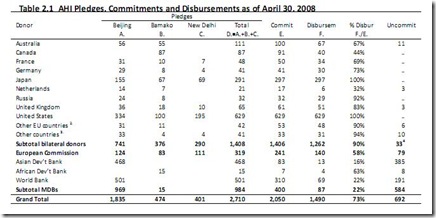# 2317
This weekend's meeting in Egypt, sponsored by the United Nations, to discuss avian flu is the sixth such gathering since 2005. While these conferences are an opportunity to share information, they are also used as a fund raising opportunity, where richer nations donate money to help in the fight against bird flu.
In the last three meetings, 2.7 Billion dollars was pledged by various nations, with the United States ($629M), Japan ($291M), and Australia ($111M) being the three most generous donor countries.
Once a pledge is made at one of these conferences, the donor country then sits down with the UN and commits to where these funds will be used.
Those committed funds are then dispersed.
Of all of the donations made to date, only those from the United States and Japan have been 100% committed and dispersed.
From the Fourth Global Progress Report on Responses to Avian Influenza and State of Pandemic Readiness.
(click to enlarge)
2.10 Among the highlights, the six largest donors (those pledging over $100 million) have reported significant progress:
• The United States has committed $629 million, all of which has been disbursed. The US has been a very active donor by providing services and grants to over 80 countries, as well as to regional and international organizations.
• Japan has fully disbursed its commitments of $277 million. Its contributions cover a wide range of countries and organizations at the regional and global levels. Through the Policy and Human Resources Development (PHRD) trust fund, Japan is also providing cofinancing for World Bank‐financed operations under the Global Program for Avian Influenza.• The European Commission disbursed $140 million out of its commitment of $241 million. The European Commission is the largest donor to the AHI Facility administered by the World Bank. The combined commitment figure for the EC and the European Union member states amounts to $464 million, of which $309 million ‐ 67 percent ‐ has been disbursed.
• Australia committed $100 million, of which $67 million has been disbursed to recipient countries, regional, and international organizations.
• The Asian Development Bank has committed $83 million, which includes $24 million to WHO and FAO and the remaining amount to various national and regional projects in Asia.
• The World Bank has developed an extensive project portfolio under its Global Program for Avian Influenza (GPAI), and committed $307 million up to end‐April 2008 to support integrated country programs in 27 countries; in addition it has committed $76 million of AHI Facility resources for projects in 33 countries. (Annex III).
These funds are designed to go to poorer nations to help them combat avian flu. That could mean increasing surveillance, funding education, financing culling operations, or reimbursing farmers for their losses, among other things.
If you wonder just who has received these funds, the UN report tells us that, as well. And as you've probably already surmised, Indonesia is the world's top recipient of the bird flu funds.
While having received at least 90 million dollars in aid to fight their bird flu problems, Indonesia has steadfastly refused to share their bird flu virus samples with the WHO since late 2006.
At the The Sixth International Ministerial Conference on Avian and Pandemic Influenza being held this weekend at Sharm El-Sheikh, Egypt, the United States has pledged another $320 million dollars for the global fight against the disease.
This will bring the United State's total pledge to just under $950 million dollars.
Other nations are expected to announce new pledges of support before the conference ends on Sunday.

